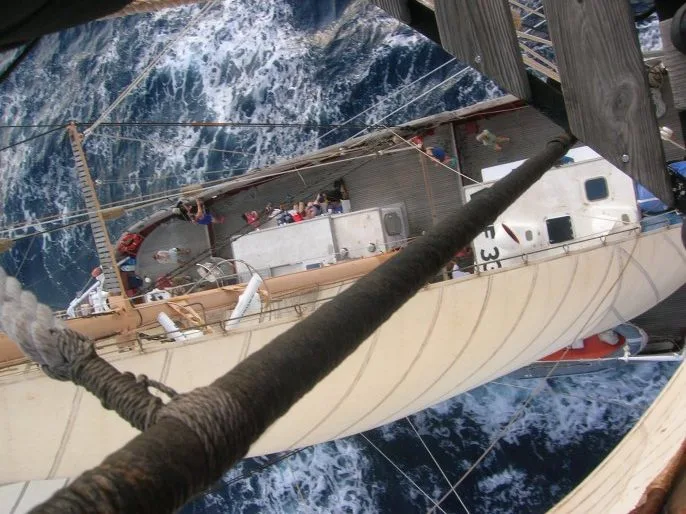Programs Blog
Back to the Mothership

Rene Francolini, Visiting Scientist, Woods Hole Oceanographic Institution
Ship’s Log
Current Position
39º11.5’N x 71º41.2’W
Course and Speed
6.5 knots, 315º
Sail Plan
Motor Sailing under Mains’l, Forestays’l, Mainstays’l
Weather
12.5º, cloudy, NNE wind force 4
Souls on BoardThere has been a photo of the Corwith Cramer in my room for the past 11 years. It has had a place in my childhood home, college dorm room, and even my current house. The form has changed overtime – at one point the 8×10 framed photograph was replaced by a 2ft x 3ft poster print, but the image has remained the same. The photograph is one I took standing atop the mast of the Cramer, looking down onto the deck of the ship, where the sails are set and the sea is in motion around us.
I was 15 years old when I participated in one of SEA’s high school SEA Semester programs. There were 24 students, and we had 10 days on land at the Woods Hole campus, followed by 10 days at sea on the Cramer. 20 short days, but those few days altered my life in ways that I could never even imagine.
Going into the program, I knew I was interested in science – I was a mathlete, competed in science league, and spent my summers on Cape Cod Bay fascinated with the horseshoe crabs, razor clams, and the ever-changing tides. However, it was only once I was taking the nautical science and oceanography classes with SEA that I realized how much more there was beyond the horizon line. And only once I was on the ship could I truly appreciate the ocean for its vastness, ferociousness, and endless amounts of scientific questions and answers it supplied. I lucked out on the students and crew for my program. The crew was a great mix of support and ridiculousness, and the comradery aboard allowed the ship to run like a well-oiled machine. My fellow students and I got along swimmingly, and it resulted in life-long friendships – some of my best to this day. For a high school nerd, it couldn’t get any better.
I returned to land with the hope of one day making my way back on the Cramer. Unfortunately, I couldn’t make the semester program happen while I was in college, and the closest I got was admiring that photograph on my wall. Though I always wondered – if I did get the chance to return to the ship, would it be as great as I remembered? Was the ocean, the science, the sailing, and the comradery really there, or did my enthusiastic high school brain inflate everything?
In the past 11 years, I have tried to take the spirit of the Corwith Cramer with me wherever I went. In that time, I completed my undergraduate and master’s degrees in biology and computational biology with the goal of applying it to oceanographic and marine based work, continued working on Cape Cod Bay, interned at other marine science institutions, and got my first job in my intended field of study at Woods Hole Oceanographic Institution. When my boss asked if I would be willing to join the students of C-285 as a visiting scientist for the Ocean Twilight Zone project, there was zero hesitation on my end – I was more than ready and more than willing to hop aboard.
It was like coming back home. My high school brain didn’t inflate the experience, and it is wonderful seeing the Cramer from a new point of view. The students are engaged both in the lab and on deck, united as a community as they work, live, sleep, and study within 134 feet of one another. As a visiting scientist I am not assigned a watch, but am listed as an “other”. I am up and working whenever science stations need to happen, allowing me to interact with all the students at varying points of the day. Being able to work with them on our scientific endeavors has been wonderful, as I get to see them confidently take charge of their group projects while also aiding me in my work. I am able to observe them as they hoist the sails, lead class discussions, and create science plans for their watch. I have had great conversations with many of them – be it about why they chose this program, how to troubleshoot an experiment, their questions about next steps in their academic careers, learning about my path as a scientist, or what it is that they are itching to get back to on land. It’s comforting, heartwarming, and inspiring to see that the spirit of the Cramer is alive and well.
Rene Francolini, C-218E, Visiting Scientist, Woods Hole Oceanographic Institution
Recent Posts from the Ships
- Ocean Classroom 2024-A collaborative high school program with Proctor Academy
- Collaborations and Long-term Commitments: SEA’s Caribbean Reef Program Sets a Course for Coastal Programs that Compliment Shipboard Experiences.
- Sea Education Association students prepare for life underway using state of the art nautical simulation from Wartsila Corporation.
- SEA Writer 2022, Magazines From the Summer SEA Quest Students
- Technology@SEA: Upgrades Allow Insight into Ocean Depths
Programs
- Gap Year
- Ocean Exploration
- High School
- Science at SEA
- SEA Expedition
- SEAScape
- Pre-College
- Proctor Ocean Classroom
- Protecting the Phoenix Islands
- SPICE
- Stanford@SEA
- Undergraduate
- Climate and Society
- Climate Change and Coastal Resilience
- Coral Reef Conservation
- Marine Biodiversity and Conservation
- MBL
- Ocean Exploration: Plastics
- Ocean Policy: Marine Protected Areas
- Oceans and Climate
- Pacific Reef Expedition
- The Global Ocean: Hawai'i
- The Global Ocean: New Zealand